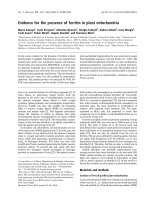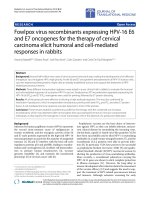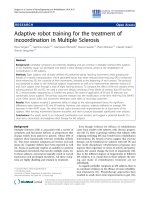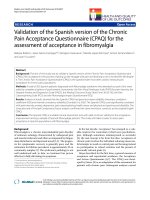Bioanalytical strategies for the quantification of xenobiotics in biological fluids and tissues 5
Bạn đang xem bản rút gọn của tài liệu. Xem và tải ngay bản đầy đủ của tài liệu tại đây (410.92 KB, 15 trang )
Chapter 5
98
Chapter 5 Determination of inorganic trace elements in
ovarian tumor cyst fluid samples by inductively coupled
plasma optical emission spectrometry
Chapter 5
99
5.1 Preface to Chapter 5
Inductively coupled plasma-optical emission spectroscopy was used to study
the variations in trace elemental concentrations between benign and malignant human
ovarian tumor cyst fluid specimens and to understand the effects of these elements in
the progression of ovarian tumor. The samples were prepared by microwave assisted
acid digestion prior to ICP-OES analysis. Many of the trace elements were identified
and their concentrations were estimated in 30 cyst fluids (15 benign and 15
malignant) samples. The elements Cr, Cd, Cu, Fe, Mn, Pb, Zn and Ni were found to
be present in all samples in significant concentration. Among them Fe, Cr, Pb, and Ni
were highly elevated in malignant samples compared with benign cyst fluids. The
excess levels of trace elements observed in the malignant tumor samples could either
be a cause or a consequence of ovarian cancer. Regarding their role in the initiation or
promotion of ovarian cancer, one possible interpretation is that the elevated levels of
Fe, Cr, Pb and Ni could have led to the formation of free radicals that adversely affect
DNA thereby causing ovarian tumor.
Chapter 5
100
5.2 Introduction
Trace elements play a vital role in all biological systems. They take part in all
metabolic and physiological processes, being components of different enzymes and
catalysts for chemical interactions in living cells [1-3]. Trace elements deficiency or
excess amount of trace elements with respect to the human physiological level has
been found in patients with certain diseases, including cancer. Study on the trace
metals for human health has been attracting much of attention in recent decades.
Several elements are usually determined in body fluids and tissues for the diagnosis
and monitoring of various disorders, nutritional deficiencies, and occupational or
environmental exposure [1-3]. The number of elements of interest has increased in the
recent decade, not only the trace metals but the heavy metals as well.
The study of the role of the trace elements has been emphasized in the search
for the possible causes of cancer. The International Agency for Research on Cancer
has proposed trace elements for their carcinogenesis [4, 5]. Some of them or their
compounds are now recognized as carcinogenic to humans. Those elements include:
Be, Cr, Co, Ni, As, Cd, Sb, Pb, Hg, and Pt. The carcinogenesis of Mn, Fe, Cu, Zn, Se
and Sr has not been completely revealed yet, however assessment of their xenobiotic
effects associated with disease progress is necessary [6]. Numerous investigations
have been carried out in studying the role of trace elements in the development or
inhibition of cancer. To understand the cause for metal induced tumors, it is important
to understand the mechanism of metal carcinogenicity.
Significant differences in the concentration of various trace metals in the
blood and tissues of the cancerous patients compared with the healthy personnel have
Chapter 5
101
been reported [7, 8]. Ovarian cancer is one of the common types of cancer worldwide
and it is mainly associated with environmental factors rather than genetics. The role of
environmental pollutants thus becomes important in the prognosis and screening of
the disease.
Several studies have been reported in the recent years regarding the trace
metal evaluation in the body liquids. Blood is a transport medium for trace metals to
and from the tissues and it provides rapid and reliable information about the trace
metal metabolism in human body [3, 6]. Consequently, whole blood, serum and
plasma have been used in biological research for the determination of trace metal
status of individuals and groups [9-11]. Nonetheless, in the case of ovarian tumor,
both benign and malignant ovarian cyst fluids are good source of information about
tumor marker and other compounds which are associated with the origin and
prognosis of tumor. Thus, ovarian cyst fluid analysis will give more reliable
information about the metal induced carcinogenicity of trace elements rather than any
other body fluids.
Determination of metal ions at trace level is difficult for the biological
samples, owing to trace amount of these metal ions and complex contents of
the matrices. Hence, preconcentration and separation technologies have to be
employed to extract analytes from the complex matrix so as to obtain suitable
concentrations of the analytes for accurate determination. Sample preparation is
an important step for metal analysis of biological samples. The choice of sample
preparation depends on the type of sample and the selection of instrument. Commonly
used preparation methods are acid digestion, microwave-assisted digestion. Similarly,
Chapter 5
102
several spectrometric techniques, such as FAAS [12], hydride generation AAS [13],
inductively coupled plasma-mass spectrometry [14], graphite furnace AAS [15],
capillary electrophoresis [16], atomic fluorescence spectrometry [17] have been
investigated for metal determination.
ICP-OES is one of the powerful tools for the determination of metals in a
variety of different sample matrices. The technique is based upon the spontaneous
emission of photons from atoms and ions that have been excited in a RF discharge.
Liquid and gas samples may be injected directly into the instrument, while solid
samples require extraction or acid digestion so that the analytes will be present in a
solution. The sample solution is converted to an aerosol and directed into the central
channel of the plasma. At its core the ICP sustains a temperature of approximately 10
000 K, so the aerosol is quickly vaporized. Analyte elements are liberated as free
atoms in the gaseous state. Further collisional excitation within the plasma imparts
additional energy to the atoms, promoting them to excited states. Sufficient energy is
often available to convert the atoms to ions and subsequently promote the ions to
excited states. Both the atomic and ionic excited state species may then relax to the
ground state via the emission of a photon. These photons have characteristic energies
that are determined by the quantized energy level structure for the atoms or ions. Thus
the wavelength of the photons can be used to identify the elements from which they
originated. The total number of photons is directly proportional to the concentration
of the originating element in the sample.
In this current study, benign and malignant cyst fluids samples of ovarian
tumor patients were studied for the estimation of metal concentration by microwave
Chapter 5
103
assisted acid digestion followed by ICP-OES technique. Moreover, the trace metals
are responsible for many complex biological interactions and such relationships are
quite complicated, hence reliable prediction of a certain disease based on trace metal
analysis requires suitable mathematical or statistical model to distinguish healthy and
diseased subjects.
5.3 Materials and methods
5.3.1 Reagents and samples
Analytical-reagent grade nitric acid (Merck), Hydrofluoric and hydrochloric
acids (Merck), Distilled, de-ionized water (DDW) and ultrapure were used for sample
preparation.
A total of 30 cyst fluids (15 benign and 15 malignant) samples were analyzed
in this study. The collection and storage of the cyst fluid was done as described in
chapter 2. 100 µL of each cyst fluid was diluted (10 -fold) to 1 mL with ultrapure
prior to the acid digestion.
5.3.2 Microwave-assisted acid digestion
The samples are digested prior to analysis with nitric acid in a closed
microwave digestion system (Milestone Inc., CT, USA). An aliquot of sample (1 mL)
was digested with 1.5 mL of HNO
3
diluted with DDW (1+2) for 30 min at 300W
power. After cooling to room temperature, the digest was poured into poly(propylene)
autosampler tubes and diluted to 10 mL with DDW. Prior to use, these tubes were
thoroughly cleaned in a sequence with detergent, water, a mixture of HNO3 (1.4 mol
L
-1
) and HCl (1.1 mol L
-1
) followed by soaking in HNO3 (0.7 mol L
-1
) and a final
Chapter 5
104
rinse with Milli-Q water. All pipette tips used for blood, plasma, cyst fluid, water and
were rinsed in a sequence with HNO
3
and DDW.
5.3.3 ICP-OES analysis
A Perkin-Elmer dual-view optima 5030 DV ICP-OES system was used for
measuring the concentrations of elements. The mode of time scan was chosen to
measure the concentration of metal ions due to its low consumption of sample.
The operational conditions of the ICP-OES system are given in Table 5.1.
Table 5.1
Operational parameters of ICP-OES.
Parameters
Parameters value
Flush pump rate
1.85 mL min
−1
Analysis pump rate
1.85 mL min
−1
Pump relaxation time
0 s
RF power
1350 kw
Nebulizer flow
26.0 psi
Auxiliary gas
1.0 lpm
Light source
ICAP
ICAP view
Dual view
5.4 Results and discussion
In the present work, trace metal analysis was carried out in the benign and
malignant cyst fluid samples. The metal elements were identified and their
concentrations were estimated. Most of the metals were present in all 30 samples and
the concentration ranges from ng g
-1
to µg g
-1
levels. Basic statistical distribution
parameters of essential trace metals (Cd, Se, Cu, Fe, Mn, Cr, Ni, Pb and Zn) in the
Chapter 5
105
malignant and benign cyst fluids are shown in Table 5.2, whereas, the average metal
concentrations are shown in Figure. 5.1, for comparative evaluation.
Figure 5.1 Comparison of average trace metals in the benign and malignant cyst fluid
samples.
Large variations were observed among minimum and maximum
concentrations of trace metals in all the groups. In the malignant samples, Cu (1.835
µg g
-1
), Fe (2.252 µg g
-1
), Pb (1.904 µg g
-1
), Cr (2.309 µg g
-1
), Zn (1.059 µg g
-1
) and
Ni (1.352 µg g
-1
) emerged as major contributors on the average, while; slightly lower
mean concentrations were observed for Cd, Se and Mn. Most of the trace metals
revealed random distribution in both samples, as shown by large standard deviation
(SD) values. Mean concentrations of Fe, Cr, Pb and Ni in the malignant samples were
significantly higher than those observed in the benign samples; however, the average
concentrations of Cd, Se, Cu and Mn were found to be slightly differing in the
malignant cyst fluids compared with the benign samples.
Chapter 5
106
Table 5.2
Distribution of trace elements in benign and malignant ovarian cyst fluid samples.
Min Max Mean SD Min Max Mean SD
Se 0.076 0.996 0.436 0.273 0.052 0.726 0.331 0.137
Cd 0.194 1.05 0.495 0.248 0.152 0.924 0.437 0.192
Cu 0.847 2.643 1.835 0.567 0.725 2.102 1.725 0.437
Fe 0.274 8.183 2.252 2.326 0.065 3.167 1.223 0.745
Mn 0.225 0.984 0.443 0.222 0.189 0.923 0.463 0.199
Cr 0.625 7.853 2.309 2.631 0.476 5.36 1.08 0.926
Zn 0.072 3.695 1.059 0.941 0.956 4.491 1.366 0.697
Pb 0.37 4.525 1.904 1.04 1.627 2.895 0.915 1.073
Ni 0.052 2.738 1.352 0.874 0.075 2.292 0.586 0.508
Malignant (concentration in µg g
-1
) (n = 15)
Benign (concentration in µg g
-1
) (n = 15)
Elements
Chapter 5
107
Chapter 5
108
In the present work, significantly elevated levels (p<0.002) of Cr were
observed in the malignant samples when compared to the benign samples. Despite its
metabolic essentiality, chromium is a recognized carcinogen. Chromium toxicity is
primarily associated with exposure to hexavalent chromium compounds rather than to
trivalent chromium compounds, which have relatively low toxicity [18, 19]. Once it
enters into the cell, chromium (VI) is partially reduced to the trivalent state, which
produces genotoxic effects [20, 21]. The observed elevated levels of chromium in the
malignant samples of ovarian tumor, in the present work, support this mechanism of
chromium carcinogenicity. Similar trend was reported in the trace elemental analysis
in cancerous and normal breast tissues, chromium levels were observed to be high in
cancerous tissues [22].
Iron is essential for the normal physiological functions in humans, since it is
an integral part of many proteins and enzymes. It plays a vital role in the regulation of
cell growth and in differentiation [23, 24]. Physiological maintenance of relatively
constant levels of iron is very crucial, since both iron deficiency and iron overload are
harmful, and can contribute to disease development in a number of ways. Iron
overload is associated with several chronic diseases, such as cancer [25]. Iron can
both cause and promote cancer. It causes tissue damage by acting as a catalyst in cell
reactions. The excess accumulation of iron in humans is associated with an increased
risk of cancer in some previous studies [26]. In the present study, higher levels
(p<0.01) of iron are observed in the malignant samples relative to the benign samples.
Though this observation is well supported by most of the earlier works [27, 28]
contradictory results have also been reported [29, 30].
Chapter 5
109
From the table, the concentration of copper in the malignant samples is
observed to be higher (p< 0.01) than that in the benign samples. Copper is found in all
living cells. Though it is essential for a wide range of biochemical processes, it is also
a potentially toxic substance. Moreover, being an important cofactor for angiogenesis,
copper can affect carcinogenesis [31, 32]. Without copper, the mediators of
angiogenesis cannot function, thereby stopping the growth of new blood vessels. The
excess copper levels observed in the benign possibly promote the malignant
transformation of ovarian tumor. The present findings in agreement with the results of
earlier studies on tumor, irrespective of the nature of the sample [33, 34]
Similarly, Pb is a toxic metal and its neurotoxic, and hematologic effects are
well known [8].The majority of lead intoxication is related to glutathione metabolism
. Lead exposure in animal models alters the reduced glutathione level. Glutathione is
an important substrate, which impacts the action of several drugs and toxins via its
conjugation in the liver. An increase in the incidence of hypertension has been
observed following lead exposure in humans [8]. In the present study, elevated levels
of Pb ((p<0.01) is observed in malignant samples.
Nickel and certain nickel compounds have been listed by the National
Toxicology Program (NTP) as being reasonably anticipated to be carcinogens. Nikel
compounds enhance cell proliferation by inhibiting apoptotic processes and allow for
cell adaptation to metal-toxicity. Nickel alters normal growth control by distinct
epigenetic mechanisms [35]. Nickel compounds have been observed to inhibit histone
acetylation a process which facilitates the accessibility of transcription factors to
DNA and this inhibition apparently contributes to tumor growth. The current study
shows the elevated levels of Ni (p<0.012) in malignant samples over benign samples.
Chapter 5
110
Many other trace elements which are known as metal carcinogens such as Be,
V and As are widely present in many samples both benign and malignant sample,
however there is no significant trend in their quantity. Regarding the role of trace
elements in the initiation or promotion of tumor, one possible interpretation is that the
elevated levels of Fe, Cr, Pb and Ni could have led to the formation of free radicals or
other reactive oxygen species that adversely affect DNA thereby causing ovarian
tumor. Tumors, characterized by unregulated multiplication of cells, need an ever-
increasing supply of essential nutrients including trace elements because of increased
cellular activities and requirements.
5.5 Conclusion
The present experimental study was undertaken to determine the variations in
trace elemental concentrations between benign and malignant human ovarian cyst
fluid specimens and to understand the effects of altered homeostasis of these elements
in the etiology of ovarian cancer. Almost all the elements identified were found to be
elevated in the malignant samples when compared with benign cyst fluids. The
obtained results indicate that the increase in malignant samples is significant (p< 0.04)
for Fe, Cr, Pb and Ni, while for the elements Se, Cd, Cu and Mn no significant
increase is observed. The excess levels of trace elements observed in the malignant
tumor samples could be a cause of ovarian cancer. Considering the possibility of free
radical formation which alter the DNA thereby causing ovarian tumor, this probably
results in an increased vascularity of malignant cyst fluids, which in turn leads to
enhancement of elemental concentrations in tumors.
Chapter 5
111
5.6 References
[1] J. Chamberlain, Pharmaceut. J. 280 (2008) 60.
[2] U.C. Gupta, S.C. Gupta, Curr. Nutrition Food Sci. 7 (2011) 221.
[3] L. Fishbein, Int. J Environ. Anal. Chem., 17 (1984) 113.
[4] L.C. Costello, R.B. Franklin, Prostate, 35 (1998) 285.
[5] J.K. Mclaughlin, L.M. Schumann, Rev. Cancer Epidemiol., 31(1983)170.
[6] American Cancer Society: Cancer Facts and Figures, American Cancer
Society, Atlanta, GA, 1993.
[7] M. Yaman, Curr. Med. Chem., 13 (2006) 2513.
[8] H.W. Kuo, S.F. Chen, C.C. Wu, D.R. Chen, J.H. Lee, Biol Trace Elem. Res.
89 (2002) 1.
[9] M. Wilhelm, U. Ewers, C. Schulz, Int. J Hyg. Environ. Health, 207(2004) 69.
[10] M. Krachler, E. Rossipal, D. Micetic-Turk, Biol. Trace. Elem. Res. 68 (1999)
121.
[11] D. Smith, M. Hernandez-Avila, M.M. Tellez-Rojo, A. Mercado, H. Hu,
Environ. Health Perspect. 110 (2002) 263.
[12] [12] A. Ide-Ektessabi, S. Fujisawa, K. Sugimura, Y. Kitamura, A. Gotoh, X-
Ray Spectrom. 31 (2002) 7.
[13] W.M. Kwiatek, A. Banas, M. Gajda, M. Galka, B. Pawlicki, G.Falkenberg, T.
Cichocki, , J. Alloys Compd. 401 (2005) 173.
[14] L. Benninghoff, D. von Czarnowski, E. Denkhaus, K. Lemke, Spectrochim.
Acta Part B., 52 (1997) 1039.
[15] L. Benninghoff, E. Denkhaus, Metal Ions Biol. Med. 5 (1998) 572.
[16] M. Kucharzewski, J. Braziewicz, U. Majewska, S. Gozdz, Biol. Trace Elem.
Res. 92 (2003)132.
[17] E.A. Hernández-Caraballo, L.M. Marcó-Parra, Spectrochim. Acta Part B, 58
(2003) 2195.
[18] E. Rojas, L.A. Herrera, L.A. Poirier, P.O. Wegman, Mutat. Res. 443 (1999)
157.
[19] S. De Flora, M. Bagnasco, D. Serra, P. Zanacchi, Mutat. Res. 238 (1990) 99.
[20] S. Langard, Sci. Total Environ. 71 (1988) 341.
[21] M. Sugiyama, Free Rad. Biol. Med. 12 (1992) 397.
[22] J.G. Ionescu , J. Novotny, V.Stejskal, A. Lätsch, E. Blaurock-Busch, M.
Eisenmann-Klein, Neuro Endocrinology Letters. 27 Suppl 1(2006) 36.
[23] T.H. Bothwell, R.W. Charlton, J.D. Cook, C.A. Finch, IronMetabolism in
Man, Blackwell Scientific, St. Louis: Oxford, 1979.
[24] N.C. Andrews, N. Engl. J. Med. 3414 (1999) 1986.
Chapter 5
112
[25] J. Alexander, Scand. J. Work Environ. Health, 19 (1993) 126.
[26] K. Norrby, I. Mattsby-Baltzer, M. Innocenti, S. Tuneberg, Int. J. Cancer, 91
(2001) 236.
[27] K H. Ng, D.A. Bradley, L M. Looi, The Br. J. Radiol. 70 (1997) 375.
[28] K. Geraki, M.J. Farquharson, D.A. Bradley, Phys. Med. Biol. 47 (2002) 2327.
[29] A.N. Garg, R.G. Weginwar, V. Sagdeo, Biol. Trace Elem. Res. 26-27 (1990)
485.
[30] S.L. Rizk, H.H. Sky-Peck, Cancer Res. 44 (1984) 5390.
[31] S. Brem, Cancer Control 6 (1999) 436.
[32] G.F. Hu, J. Cell Biochem. 69 (1998) 326.
[33] K. Geraki, M.J. Farquharson, D.A. Bradley, Phys. Med. Biol. 47 (2002) 2327.
[34] K. Geraki, M.J. Farquharson, D.A. Bradley, Phys. Med. Biol. 49 (2004) 99.
[35] I.D. Capel, M.H. Pinnock, D.C. Williams, I.W. Hanham, Oncology 39 (1982)
38.









